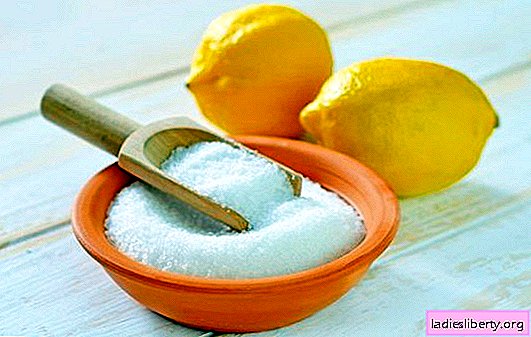
This white crystalline substance, packaged in bright plastic bags, recently, by right, took its rightful place on the shelves of small shops and supermarkets.
And although citric acid is widely used in the food and petroleum industries, in medicine, cosmetics, in construction (as an additive to cement), it is also successfully used in everyday life.
Thanks to its cleaning and bleaching properties, citric acid has "tasted" many of our enterprising housewives, who use it to clean kitchen utensils and even to "rejuvenate" washing machines.
Scale and rust are the enemies of kitchenware and home appliances
Scale is formed on the inner surface of the pot or kettle, as well as on the heating element of electric kettles, during their operation. It appears over time due to the deposition of salts and the layering of metal particles contained in tap water.
* Scale contributes to the premature failure of electrical and ordinary household appliances.
* Due to the low thermal conductivity, the scale formed on the electric heater leads to additional energy consumption.
* In addition, particles of scale, dissolving in water, enter the human body and adversely affect its urinary system and kidneys.
* Such a harmful formation, such as scum, is sometimes difficult to cope with even with the help of expensive, well-publicized means of household chemicals. And here, more than ever, by the way, ordinary citric acid comes to the rescue, which is always at hand in any home.
We clean teapots from a scum citric acid
There are several cleaning methods for this.
Method number 1 - simplest. We take an ordinary (non-electric) kettle, scum and rust are visible on the bottom and on the walls of which. Fill the kettle with tap water, pour one (25 gram) bag of edible citric acid into the water and set the kettle on fire. When the kettle begins to boil, the scale, under the influence of citric acid, together with rust, is well separated from its walls. It remains only to drain the water and rinse the kettle. In order to prevent this procedure must be repeated at least once a month.
Method number 2 - in a teapot a lot of scum. Dilute 2-3 sachets of citric acid in 1 liter of water. Fall asleep in the kettle and heated. Then the water in the kettle is thoroughly shaken. Again put on the fire and bring to a boil. As soon as the water boils, the fire is turned off and the kettle is left with the hot solution until it cools completely. After repeating such an operation 2-3 times, your kettle will be cleared so that you simply will not recognize it.
Method number 3 - dirty, neglected kettle all covered with scum and rust. In the kettle pour water. Add a tablespoon of baking soda, boil. Water is drained. Again pour water. Add a tablespoon of citric acid. Boil about half an hour on low heat. Boiled water is drained and immediately poured fresh. Add half a cup of vinegar, boil for 30 minutes and drain again. I assure you that as a result of such an intensified, combined cleaning of scale and rust, there will be no trace left.
Method number 4 - in the kettle, scale covered the entire heating element. From this kettle can quickly fail. But before you start cleaning it, you need to remember that vinegar should not be used for electric kettles. But citric acid in any cases an indispensable tool for cleaning from scale. It is necessary to dilute 1-2 sachets of acid in 1 liter of water. Pour the solution into the kettle and boil. When boiling, the plastic case of the kettle cleans well, the dark deposit disappears, the scale flakes off. It remains only to drain the dirty water, re-boil the kettle in clean water and drain it again, so that residues of scale do not get into tea or coffee.
Clean the iron from limescale
Not everyone probably knows that on the heating element of the iron, over time, scaling also forms. Therefore, the iron must be periodically cleaned not only from above, but also inside.
To do this, in a glass of water diluted with a bag of citric acid.
The prepared solution is poured into the tank electric iron. Turn on the iron, press the "Steam" button and set the maximum heating temperature.
Soon you will see for yourself how the remnants of scale and dirt will pop out from the holes in the sole of the iron, along with the steam.
This is the dirt that, when ironed, could get on your white shirt or sheets. The remaining water in the tank is drained and the cleaning process is repeated two or three times.
We lighten silver and rub furniture with citric acid
* It is known that silver jewelry is very beautiful. They are practical and costly - relatively expensive. However, silver quickly fades and often loses its appeal. But if you drop a silver chain, a ring or a bracelet in a heated solution with citric acid and hold it there for some time, then the formed oxides are removed and the silver takes on its wonderful original appearance.
* Silver can even be boiled in citric acid solution. After such a "cooking" the metal becomes perfectly clean.
* Often citric acid is used not only as a cleaning agent, but also a disinfectant. A kitchen cloth, shiny and chrome-plated surfaces of sinks, kettles, coffee pots and the inside surfaces of the microwave are wiped with a cloth moistened with citric acid solution.
And if you add lemon juice (in the ratio of 2 to 1) to olive oil, then with this smelling agent it is very good to rub the outer surfaces of polished furniture, which will literally shine with its natural shine.
To make your car last longer
- The deposition of calcium and magnesium salts contained in tap water leads to premature wear and breakage of the heat-electric heating element (heating element) in the washing machine.
- And the cost of heating elements is equal to one third the cost of the entire machine. It turns out that the more expensive your car is, the more expensive it will be to repair the heating element.
- In addition, scale complicates the process of heating the heating elements and increases the power consumption. When washing, overgrown with heating elements, consumes electricity by 20-30% more than clean.
Therefore, in order for the machine to serve longer, and washing costs less, you must use citric acid.
Clean the washing machine with limescale
Instead of washing powder, 200 grams of citric acid are poured into the machine’s powder compartment (you can pour the acid directly onto the drum). They put in the washing mode for one and a half to two hours at a temperature of 80-90 degrees and, "idle", they begin to wash things without any things. After washing is completed, open the door of the drum. Having bent away sealing rubber, check that under it the remnants of a scum did not accumulate. Then you need to open the machine drain cover and see if there are large particles of scale there that could fall away from the heating element.
After such a cleansing procedure, your "assistant" will work much better and longer.
In order to prevent, you can use another method. At the beginning of washing white laundry, add 20 grams of citric acid to the laundry detergent, which, among other things, has a bleaching property.
In this case, the quality of washing will be excellent, and citric acid will only benefit the heating elements and machine drum.
Take care of your "helper"
- After washing, it is necessary to wipe the rubber parts of the washing machine with a soft, dry cloth to prevent mold from forming under them.
- Try as often as possible to leave the door of the drum ajar, but so as not to accidentally touch her legs and do not damage.
- Do not wash frequently at high temperatures. As practice shows, modern powders successfully cope with pollution already at a temperature of 50 degrees.
To protect your indispensable "helper" from scale and extend its service life, you need to clean it with citric acid at least once a year.











